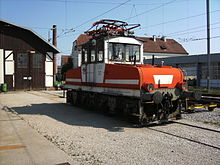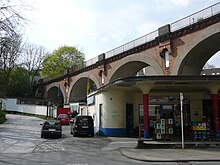Loh – Hatzfeld railway line
| Loh-Hatzfeld | |||||||||||||||||||||||||||||||||
|---|---|---|---|---|---|---|---|---|---|---|---|---|---|---|---|---|---|---|---|---|---|---|---|---|---|---|---|---|---|---|---|---|---|
| Route length: | 4.5 km | ||||||||||||||||||||||||||||||||
| Gauge : | 1435 mm ( standard gauge ) | ||||||||||||||||||||||||||||||||
| Power system : | 550 V = | ||||||||||||||||||||||||||||||||
| State (D): | North Rhine-Westphalia | ||||||||||||||||||||||||||||||||
|
|||||||||||||||||||||||||||||||||
The small railway Loh-Hatzfeld was an approximately five-kilometer branch line from Barmer district Loh to also situated in Barmen district Hatzfeld . Since the unification of the two cities of Barmen and Elberfeld to Wuppertal , the beginning and end of the railway line have been in the Wuppertal urban area.
history
The standard gauge small railway was built in 1894 by the city of Barmen and branched off from the Wuppertal Northern Railway of the Rhenish Railway Company at Wuppertal-Loh station . The first section connected the Barmer slaughterhouse to the railway network on the current site of Wuppertaler Stadtwerke AG (Bromberger Straße). Steam locomotives from the Prussian State Railways drove the route, which was initially not electrified .
In 1911 the line to Hatzfeld was extended (opening on September 1) to enable the factories located there on the watershed between Ruhr and Wupper (including Herberts-Lacke, now DuPont and now Axalta Coating Systems ) to have a siding . For this purpose, the city of Barmen founded a small railway company. In December 1920 there was a further extension to a factory site at the Hatzfeld water tower , where the final length of almost five kilometers was reached. A further extension of the line to Langenberg was considered, but not implemented.
With the electrification from 1910, the section from the slaughterhouse was used in addition to goods traffic with trams for passenger traffic. A short time later, the line was linked with the city's other standard-gauge tram network, so that the suburb of Hatzfeld could now also be reached from the center. Over the years, three electric locomotives bought by the city itself took over the freight transport.
The greatest freight volume was recorded from 1923. In 1914/15 37,841 t were transported, in 1928 89,094 t. From the state railway were coals until Umladebahnhof delivered on the spacious grounds of the slaughterhouse, which were transported there via the urban tram network, among others, the thermal power station in Clef. From 1940 until the end of operations, the Herberts paint factory was the most important affiliate.
With the renovation of the center of Barmer in 1963, the freight railway was banned from the city center. Passenger traffic between the center and Hatzfeld was also discontinued in the same year. Deprived of most of the freight volume, the operator (from 1948 Wuppertaler Stadtwerke AG, transport division ) only served the factory connections of the Hatzfeld industrial companies. With the progressive shift of goods traffic to the road, the small railroad also came to a gradual end. The final end came at the end of 1979, on February 1, 1980 the line was officially closed.
Routing and engineering structures
The branch of the line is at the Wuppertal-Loh train station . A large brick viaduct was built to cross Schönebecker Strasse . After crossing the street at an acute angle, the route in Schönebecker Busch ran parallel to Schönebecker Straße through the Rott district. Behind the level crossing on Carnaper Strasse, the line reached the slaughterhouse site. The extension from 1911 began behind the slaughterhouse on Schützenstrasse and led along Winchenbachstrasse and Leimbach in a wide arc up to the Hatzfeld water tower.
Locomotives

After the line was electrified, the city purchased two new electric locomotives in quick succession to start operating independently. The first, built by Maffei / SSW in 1910 , was given vehicle number I (later renumbered to 608, renumbered to 3608 in 1978), the second, built by Maffei / AEG in 1912 , was given number II (later 609 or 3609). No. II was nicknamed "Big Berta" because of its beefy appearance. Both locomotives were in use until they ceased operations and were sold to Stern & Hafferl in Austria in July 1980 . The older of the two locomotives first came to the NWP as the E 20.010 , and from May 1982 to the LVE , where it is still in use , now as the E 24.010 . The younger of the two came to the Linz local railway as E 20 009 (later E 22 006). In March 2006 it was scrapped in Lambach .
A third locomotive (road number III, later 610), built by Schöndorff / AEG, was acquired especially for coal transport in 1931 and retired after it was discontinued in 1963.
literature
- Wolfgang Reimann : Wuppertal Railways. EK-Verlag, Freiburg 1982, ISBN 3-88255-560-2 .
- Dieter Höltge: Trams and light rail vehicles in Germany. Volume 5: Bergisches and Siegerland, from Wuppertal to Bonn. EK-Verlag, Freiburg 1996, ISBN 3-88255-333-2 , chapter Kleinbahn Loh-Hatzfeld , p. 50; Chapter fleet list , p. 58.
- Bernd Franco Hoffmann: Disused railway lines in the Bergisches Land. Sutton-Verlag, Erfurt April 2013, ISBN 978-3-95400-147-7 .
- Helmut Roggenkamp: The electric traction in the freight traffic of the non-federally owned railways and the works railways. In: Lok Magazin , issue 117, November / December 1982, pp. 458–469.
Web links
- MLHF: 5. The Loh-Hatzfeld Kleinbahn on Youtube
- Article with many photos on bahnen-wuppertal.de
- The section Schönebecker Straße - Schlachthof on tramtracks.de
- The section Schlachthof - Winchenbachstraße on tramtracks.de
- The section Winchenbachstraße - Hatzfeld on tramtracks.de
Individual evidence
- ^ Jörg Petzold: Kleinbahn Barmen-Loh-Hatzfeld . in: Die Museumseisenbahn 1/2011, p. 36.
- ↑ Pictures and comments of the transport to Austria. Retrieved March 20, 2010.
- ↑ Picture of the scrap train with annotations. Retrieved March 20, 2010.

